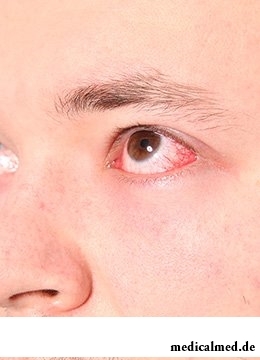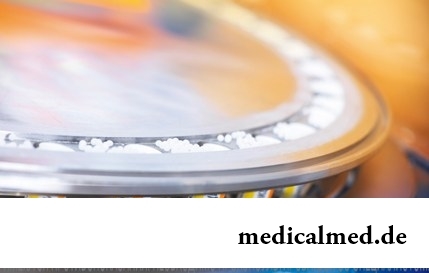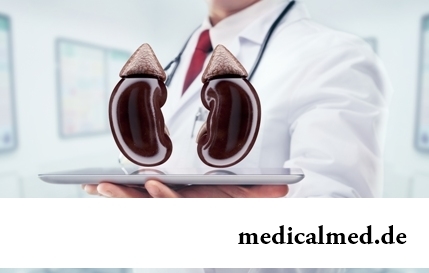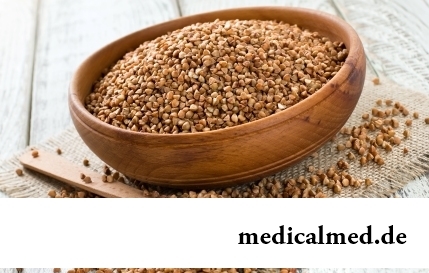





Hemorrhagic syndrome
 Owing to changes in one or several links of a hemostasis there is a tendency to bleeding of mucous membranes and to a skin hemorrhage which is called a hemorrhagic syndrome.
Owing to changes in one or several links of a hemostasis there is a tendency to bleeding of mucous membranes and to a skin hemorrhage which is called a hemorrhagic syndrome.
In medicine distinguish five types of a syndrome, namely:
- Sinyachkovy, or petekhialno-spotty – it is typical for a trombotsitopatiya, hereditary deficit of factors of coagulation, thrombocytopenia, a dysfibrinogenemia and a hypofibrinogenemia. At a hemorrhagic syndrome of this type there is a deficit II, V and X blood-coagulation factors;
- Gematomny – arises against the background of hemophilia And yes In, VIII, IX and XI blood-coagulation factors are characterized by deficit. At the patient dysfunction of a musculoskeletal system gradually develops, there are intense painful hemorrhages in soft tissues and joints. After several hours after an injury late bleeding, characteristic of this type of a syndrome, begins;
- Mikrotsirkulyatorno-gematomny, or mixed – it is typical for the IDCS and an angiohemophilia, often arises at overdose of trombolitik and anticoagulants, heavy deficit of factors of a prothrombin complex, emergence of immune inhibitors of factors of VIII and IX in blood. The mixed hemorrhagic syndrome by a combination in a wall of intestines and retroperitoneal space of separate big hematomas to petekhialno-spotty skin hemorrhages is characterized;
- Vaskulitno-purpurny – develops against the background of immune and infectious vasculites, it is characterized by development on an inflammatory basis of a hemorrhage in the form of an erythema or rash, accession of intestinal bleeding and nephrite is peculiar to it. This type of a syndrome is easily transformed to the IDCS;
- Angiomatous – develops in zones of arteriovenous shunts, angiomas and teleangiectasias, formation of the persistent local hemorrhages connected with zones of vascular pathology is peculiar to it.
According to statistical data, the hemorrhagic syndrome at women meets a little more often, than at men.
Hemorrhagic syndrome: reasons and symptoms
Defeat of a vascular wall and its structure, quantity and functions of thrombocytes, and also disturbance of a coagulative hemostasis are the reasons of development of a hemorrhagic syndrome. In one cases of pathology meet often, in others – it is extremely rare that it is important to consider at diagnosis of a disease.
The acquired syndrome form most often develops against the background of a secondary trombotsitopatiya and thrombocytopenia, deficit of factors of a prothrombin complex, the IDCS and a hemorrhagic vasculitis.
Recently development of a hemorrhagic syndrome is more and more often connected with reception of medicines which break aggregation of thrombocytes and coagulability of blood. Also, Vergolf's disease, hemophilia and deficit of a prothrombin can act as the reason of development of a syndrome.
As signs of a syndrome faints, bleedings of various type and degree of complexity, and also bleeding (hemorrhagic diathesis) act.
Hemorrhagic syndrome at newborns
The hemorrhagic syndrome (disease) of newborns is a consequence of insufficient synthesis of factors of the Thrombin index. Because of deficit of vitamin K at children it proceeds in the form of an inborn coagulopathy.
According to statistical data, 20 years ago the hemorrhagic syndrome occurred at newborns in 0,25-0,5% of cases, today universal use in clinical practice of 1 mg of a dose of vitamin K allowed to lower this indicator to 0,01% and less.
Development of a syndrome in newborns can be caused by several factors, namely:
- Reception by the pregnant woman of antibiotics, anticonvulsant and antitubercular drugs, the anticoagulants of indirect action getting through a placenta;
- Late applying of the child to a breast, prematurity of the baby, a perinatal hypoxia and long parenteral food;
- Sprue, use of antibiotics of a broad spectrum of activity to the child and artificial feeding.
In rare instances the hemorrhagic syndrome at the newborn is shown in the first day of life, more often it develops for 5-7 days.
Diagnosis of a hemorrhagic syndrome
First of all, for confirmation of the diagnosis it is necessary to carry out the developed blood test and urine, the elementary coagulative tests, to carry out calculation of thrombocytes of peripheral blood, according to indications the sternal puncture can be required.
The doctor at diagnosis has to consider duration of bleeding and a blood clotting time, to check it for the content of fibrinogen and a prothrombin, and also to define tolerance (stability) of plasma to heparin.
Prevention and treatment of a hemorrhagic syndrome
For the prevention of development of a syndrome in newborn children it is recommended to carry out the following measures of prevention:
 To enter subcutaneously vitamin K to premature babies;
To enter subcutaneously vitamin K to premature babies;- To put the newborn child to a breast in the first half an hour after the birth.
Treatment of a hemorrhagic syndrome at babies is done by means of intramuscular administration of vitamin K, and also feeding of the baby the decanted maternal or donor breast milk seven times a day.
Regardless of age of the patient, at development of bleeding the emergency medical service directed to its stop has to be provided. For the warning of development of bleeding to adult patients can appoint reception of the gemostatik increasing coagulability of blood. In an individual order, depending on indications and a condition of the patient, the doctor can appoint the subsequent drug treatment.
The hemorrhagic syndrome at women, men and newborn children is shown as tendency to bleeding of mucous membranes and a skin hemorrhage. The emergency hospitalization and use of the adequate treatment including a bleeding stop, recovery of level of vitamin K in an organism and also use of the medicines increasing coagulability of blood is necessary for patients.
The liver is the heaviest body in our body. Its average weight makes 1,5 kg.

For most of the working people the problem of having a snack is particularly acute enough. Sooner or later there is a question: what is possible quickly for a sja...
Section: Articles about health
The problem of diagnosis was and remains to one of the most important in medicine. From that, the reason of an indisposition of the patient will be how precisely defined, eventually success of treatment depends. In spite of the fact that the majority of the diagnostic methods applied in about...
Section: Articles about health
For the help to doctors in the choice of optimal solutions for treatment of various diseases the Cochrane scientific organization (Cochrane) conducts joint researches with representatives of scientific community around the world. The analysis of a series of the conducted researches of the drug Oscillococcinum® relating to group of cold remedies became one of the last methanolyses....
Section: Articles about health
80% of women at least once to lives complained of discomfortable feelings to breasts, consolidations and nagrubaniye. These are mastopathy symptoms. Mas...
Section: Articles about health
Kidneys perform the most important function of clarification of blood from those products of metabolic processes which cannot be used by an organism for obtaining energy and construction of new cells. With the urine produced by kidneys from a body of the person bulk is removed...
Section: Articles about health
Herpes simplex of the first type (the infectious disease which is shown periodic bubble rashes on lips is called) – one of the most widespread illnesses. Statistically, only 5% of inhabitants of our planet are unreceptive to its activator, and the reasons of this feature are still not found out. Other people are virus carriers....
Section: Articles about health
Coffee – favourite drink of many. For the last decades it more than once already declared very harmful, extremely useful and even...
Section: Articles about health
There is a lot of fans of beer in our country. Statistically, on each average Russian (including women and children) in a year about 60 liters of this drink are consumed. It is not a lot of, as in the Czech Republic or Germany, but figure all the same impressive. Radova...
Section: Articles about health
Olive oil – the product capable to make a powerful contribution to health of the person if it includes it in the diet. The rich vitamin composition of oil does it by a product number one from many diseases including from deadly. Only two tablespoons of oil from olives in day prevent emergence of diseases of vessels and heart, cancer, problems with digestion, presenilation, a depression and many other illnesses which treatment would demand a lot of time and forces. Let's consider on...
Section: Articles about health
Cellulitis - very widespread cosmetic shortcoming which arises approximately at 80% of women sooner or later. Emergence ег...
Section: Articles about health
The drugs stopping or oppressing life activity of pathogenic microorganisms are widely applied in clinical practice from 40th years of the last century. Originally antibiotics were called only substances natural (animal, vegetable or микробног...
Section: Articles about health
People know that thermal sources have salutary force long ago. Treatment by natural waters is one of the most ancient methods of disposal of the most different diseases. Bathtubs, souls, wrappings and inhalations, in combination with water reception inside help to improve a condition of the patients suffering from disturbances of work of a musculoskeletal system, bodies of digestive tract, cardiovascular, nervous, respiratory and secretory system, skin and endocrine п...
Section: Articles about health
Statistically, in Russia about 34% of citizens smoke. Most of consumers of tobacco has problems about health sooner or later...
Section: Articles about health
Statistically, pathologies of a thyroid gland in the world more than 500 million people have. Failures in work of this body lead to heavy disbolism, development of heart diseases, vessels, a reproductive and nervous system. In hard cases excessive...
Section: Articles about health
A little more than a century ago goat milk was a traditional food stuff of most of Russians. Unfortunately, today on tables of our compatriots it appears extremely seldom. The reason that the use of so useful product practically came to naught, not only in very modest volumes of its production and, respectively, rather high cost. Potential consumers are just insufficiently informed on unique properties of goat milk and that advantage which...
Section: Articles about health
Dogrose – one of the most widespread adornment and medicinal plants growing practically in all territory ours...
Section: Articles about health
Scientists have no unambiguous opinion on a proximate cause of emergence of a carcinoma cutaneum today. Only the factors promoting development of this illness are precisely established. Treat them: long impact on skin of ultraviolet rays, radioactive...
Section: Articles about health
The cosmetics intended for improvement of a condition of skin, nails and hair are used by each woman. Expenses on regular acquisition of the fashionable widely advertized products of well-known companies for many become very notable and significantly burden the family budget. Meanwhile, there is a number of inexpensive pharmaceutical drugs which can quite be applied in the cosmetic purposes. At the same time the effect of their use is often more noticeable, than result of use of the most expensive...
Section: Articles about health
Stroke (acute disorder of cerebral circulation) – one of the most widespread neurologic diseases. Annually in the world...
Section: Articles about health
For anybody not a secret that the modern person eats not as his ancestors. For the last 100 years in broad access there were absolutely new products which are result of use of the latest technologies in food production. Significantly changed спо...
Section: Articles about health
Smoking not only exerts a negative impact on the state of health of the consumer of tobacco products, but is an air polluter the substances potentially dangerous to people around. In recent years significantly the number of the people aiming to get rid of an addiction increased. Business this difficult: having left off smoking, the person immediately begins to suffer from abstinence. Besides, many yesterday's smokers feel at first great disappointment as улучш...
Section: Articles about health
Extracorporal fertilization – one of the most modern methods of controlling with infertility. So far it already helped znach...
Section: Articles about health
Reactive pancreatitis - the disease which is characterized by inflammatory process in a pancreas which arises most often because of excess activity of digestive enzymes. It − the emergency state which treatment has to take place in хирургич...
Section: Articles about health
Zone hypostases under eyes - very widespread problem giving to people is a lot of inconvenience. Hypodermic fabric in these parts has very loose structure and almost does not contain collagenic fibers. Besides, the skin covering подглазья constantly is exposed to compression and stretching when the person blinks, blinks, etc. These features also create premises for emergence of the so-called bags which are giving to the face a tired and sickly look, and also visually adding increased...
Section: Articles about health
For many women the word "fat" sounds as a sentence. In aspiration to an ideal figure they try to exclude, first of all, from with...
Section: Articles about health
The phenomenon of the panic attack is known long ago, but the reasons of its emergence still are up to the end not found out. It is established that more than 30% of people at least once in life become the victims of very unpleasant phenomenon: without everyones on that the reasons they have a feeling of horror, with...
Section: Articles about health
Coffee - the tonic loved by many for the invigorating aroma and deep taste. Having the stimulating effect, coffee increases working capacity, promotes concentration of attention, fights against drowsiness and improves mood. Statistically, about 30% of inhabitants of the planet regularly use coffee, from them more than 8% are "coffee-achievers" - the persons using more than 3 cups of drink a day....
Section: Articles about health
